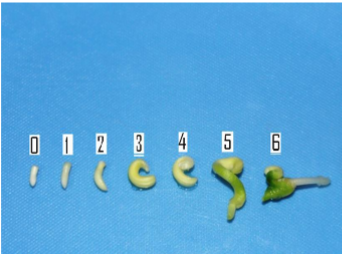In vitro embryo rescue of interspecific hybrids of oil palm (Elaeis oleifera x Elaeis guineensis)
DOI:
https://doi.org/10.20873/jbb.uft.cemaf.v2n2.alvesKeywords:
vegetable oil, zygotic embryos, genetic breedingAbstract
The oil palm (Elaeis guineennsis Jacq.) is the plant with major oil yield in tropical areas over the world. Pará state is the major producer of Brazil. However, the production of resistant hybrids (Elaeis oleifera x Elaeis guinennsis) to several diseases is necessary, in spite of less productive, is a viable alternative for areas where occur more aggressive diseases. The aim of this research was to rescue in vitro embryos of four varieties of interspecific hybrids of oil palm (Elaeis oleifera x Elaeis guineensis) in different media. Four varieties were tested: (1) Cj-2141; (2) CI-2061; (3) Cj-502 and (4) Cj-494. Four media were tested: (T1) half strength MS medium (½ MS), (T2) MS, (T3) MS + 0.5mg L-1 1-naphthaleneacetic acid (NAA) and 6-benzylaminopurine (BAP) and (T4) ½ MS+ 0.5mg.L-1 NAA and BAP. All media were supplemented with 0.17g.L-1 NaH2PO4, activated charcoal (0.25%), sucrose (3%) and solidified with phytagel (0.2%). The most germination rate of interspecific hybrids embryos was obtained on ½ MS medium, supplemented with 0.17g.L-1 NaH2PO4, activated charcoal (0.25%), sucrose (3%) and solidified with phytagel (0.2%). The variety CI-2061 presents the best capacity to develop normal seedlings.
References
Alves, S. A. O. Regaste de híbridos interespecíficos de dendezeiro (Elaeis oleifera x Elaeis guineensis). Dissertação (Mestrado em Botânica) -Universidade Federal Rural da Amazônia/Museu Paráense Emilio Goeldi, 2007.
Asano, Y.; Imagawa, M. (1999), Hybrid seed formation among Dioscorea opposita Thunb. cvs. Nagaimo, Ichoimo, Tsukuneimo and Dioscorea japonica Thunb. Journal of the Japanese Society for Horticultural Science, 68, 591-597.
Cavalcante, A. S. L. Respostas morfogenéticas in vitrode açaizeiro(Euterpe oleracea L.) e de cupuçuazeiro (Theobrama grandiflorum (Wild. Ex Spreng) Schum). Tese (Doutorado em Fitotecnia)-Universidade Federal do Ceará,2001.
Carvalho, A. V.; Alves, B. J. R.; Reis, V. M. (2006), Resposta do dendezeiro à adição de nitrogênio e sua influência na população de bactérias diazotróficas. Pesquisa Agropecuaraia. Brasileira, 41, 293-300.
Cruz, C. D.; Regazzi, A. J. (2001), Modelos biométricos aplicados ao melhoramento genético. 2a. Ed. Viçosa: Universidade Federal de Viçosa, 390p.
Fantini Junior, M. and Graça, M. E. C. Propagação in vitrode Eucalyptus saligna (1990), In: Congresso Florestal Brasileiro. Anais: São Paulo: Sociedade Brasileira de Silvicultura, 373-378p.
Islam, M. M.; Wahed, S. A.; Khan, S. A. K. U. (2004), Studies on callus induction and regeneration from dehulled rice (Oryza sativaL.) seeds. Plant Tissue Culture and Biotechnology,14, 155-160.
Khatun, M. M.; Ali M. H.; Desamero, N. V. (2003), Effect of genotype and culture media on callus formation and plant regeneration from mature seed scutella culture in rice. Plant Tissue Culture and Biotechnology, 13, 99-107.
Kanchanapoom, K.; Domyoas; P. (1999), The Origin and Development of Embryoids in Oil Palm (Elaeis guineensisJacq.) Embryo Culture.Science Asia, 25, 195-202. Lemos, O. F. P. Mutagênese e tecnologia in vitrono melhoramento genético de pimenta-do-reino (Piper nigrumL.). Tese (Doutorado em Agronomia). Escola Superior de Agricultura “Luiz de Queiroz”, Universidade de São Paulo, 2003.
Murashige, T. and Skoog, F. (1962), Revised medium for rapid growth and bioassays with tobacco tissue culture. Physiologia Plantarum, 15, 473-497.
Silva, V. S. Regeneração in vitrode embriões de Cocos nuciferaL. Dissertação (Mestrado em Ciências).Escola Superior de Agricultura “Luiz de Queiroz”, Universidade de São Paulo, 2002.
Surre, C.; Ziller, R. (1969), La palmera de aceite. Barcelona: Ed. Blume (Coleccion Agricultura Tropical), 231p.
Teixeira, J. B.; Söndahl, M. R.; Kirby, E. G. (1993), Somatic embryogenesis from immature zygotic embryos of oil palm. Plant Cell Tissue and Organ Culture, 34, 227-233.
Viegas, I. de J. M. andMuller, A. A. (2000), A cultura do dendezeiro na Amazônia brasileira. Belém: Embrapa-Cpatu; Manaus: Embrapa-CPAA, 374p.

Published
How to Cite
Issue
Section
License
Copyright (c) 2024 - Journal of Biotechnology and Biodiversity

This work is licensed under a Creative Commons Attribution 4.0 International License.
Authors who publish with this journal agree to the following terms:
Authors retain copyright and grant the journal right of first publication with the work simultaneously licensed under a Creative Commons Attribution License (CC BY 4.0 at http://creativecommons.org/licenses/by/4.0/) that allows others to share the work with an acknowledgement of the work's authorship and initial publication in this journal.
Authors are able to enter into separate, additional contractual arrangements for the non-exclusive distribution of the journal's published version of the work (e.g., post it to an institutional repository or publish it in a book), with an acknowledgement of its initial publication in this journal.
Authors are permitted and encouraged to post their work online (e.g. in institutional repositories or on their website) prior to and during the submission process, as it can lead to productive exchanges, as well as earlier and greater citation of published work (Available at The Effect of Open Access, at http://opcit.eprints.org/oacitation-biblio.html).


